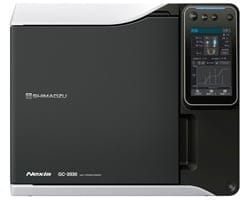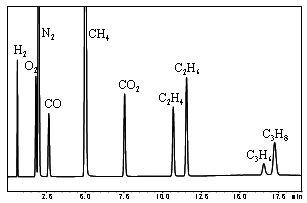Analysis System for Gases in Rechargeable Lithium-Ion Batteries

A single instrument can analyze inorganic gases, including hydrogen and light hydrocarbons
The deterioration of lithium-ion rechargeable batteries is investigated by using a gas chromatograph to evaluate the composition and volume of gases produced inside the battery. With conventional analysis methods, a flame ionization detector (FID) is used to detect low-concentration hydrocarbons, and a thermal conductivity detector (TCD) is used to analyze inorganic gases, which means that multiple detectors (instruments) are required.
The Shimadzu analysis system for gases in rechargeable lithium-ion batteries, which uses a high-sensitivity gas chromatograph, enables the simultaneous analysis of inorganic gases and light hydrocarbons with a single instrument using appropriate separation columns. In addition, configuring multiple instrument parameters is no longer necessary, substantially reducing the time involved.
Example of the Simultaneous Analysis of Gases in a Rechargeable Lithium-Ion Battery
A simultaneous analysis of inorganic gases (H2, O2, N2, CO, and CO2) and light hydrocarbons (CH4, C2H4, C2H6, and C3H8) was performed using the Shimadzu analysis system for gases in rechargeable lithium-ion batteries.

Note: Off-line sample injection using a gas-tight syringe
Note: A small amount of contamination with air might occur during sampling.
- For details, refer to GC Application Data Sheet “No. 7 Simultaneous Analysis of Evolved Gas Produced by the Degradation of a Lithium-Ion Battery.”


